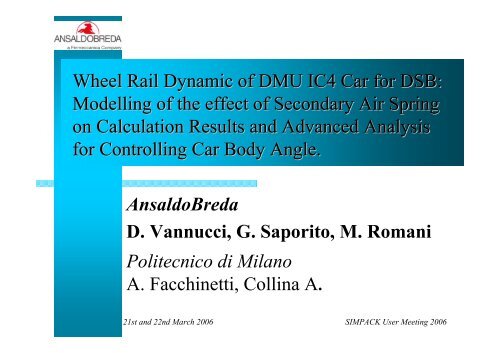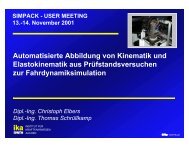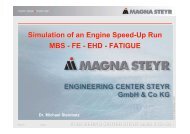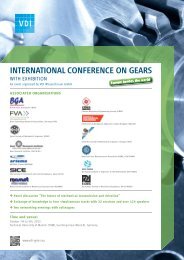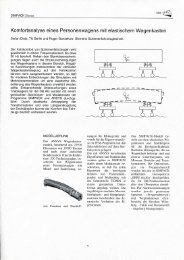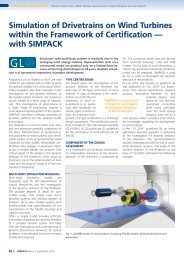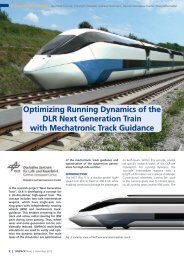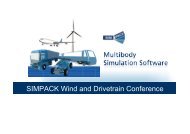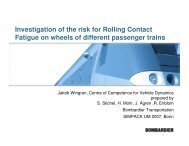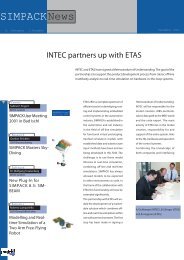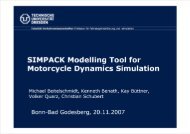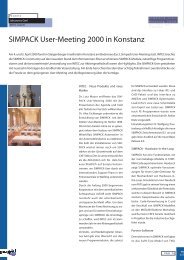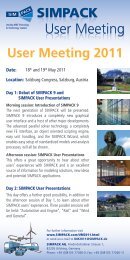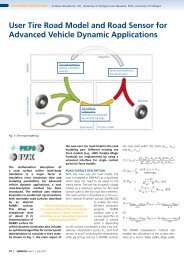Italy Wheel Rail Dynamic of DMU IC4 Car - Simpack.com
Italy Wheel Rail Dynamic of DMU IC4 Car - Simpack.com
Italy Wheel Rail Dynamic of DMU IC4 Car - Simpack.com
You also want an ePaper? Increase the reach of your titles
YUMPU automatically turns print PDFs into web optimized ePapers that Google loves.
<strong>Wheel</strong> <strong>Rail</strong> <strong>Dynamic</strong> <strong>of</strong> <strong>DMU</strong> <strong>IC4</strong> <strong>Car</strong> for DSB:<br />
Modelling <strong>of</strong> the effect <strong>of</strong> Secondary Air Spring<br />
on Calculation Results and Advanced Analysis<br />
for Controlling <strong>Car</strong> Body Angle.<br />
AnsaldoBreda<br />
D. Vannucci, G. Saporito, M. Romani<br />
Politecnico di Milano<br />
A. Facchinetti, Collina A.<br />
21st and 22nd March 2006 SIMPACK User Meeting 2006
Summary<br />
Introduction<br />
AB engineering and MBS<br />
<strong>IC4</strong> Vehicle description<br />
The secondary suspension<br />
– Secondary suspension study for <strong>IC4</strong><br />
– Different levels <strong>of</strong> modelling the suspension<br />
– remarks<br />
Developing <strong>of</strong> a test bench air spring characterizing<br />
– Description<br />
– Test <strong>of</strong> air spring<br />
– Static characterizing<br />
– <strong>Dynamic</strong> characterizing<br />
Developing <strong>of</strong> the numerical model - <strong>Simpack</strong> co-simulation<br />
– Simple lumped parameter<br />
– Finite element model<br />
Conclusion<br />
21st and 22nd March 2006 SIMPACK User Meeting 2006
AB Engineering and MBS<br />
In 1998 AB introduced MBS in<br />
the engineering process<br />
Typical application: wheel rail<br />
vehicle<br />
MBS Target:<br />
– Testing the vehicle behaviour<br />
according to UIC518<br />
<strong>com</strong>plete models are involved<br />
– Components design support<br />
Usually detailed sub models are<br />
involved<br />
21st and 22nd March 2006 SIMPACK User Meeting 2006
AB Engineering and MBS<br />
Extension <strong>of</strong> MBS simulation to the<br />
<strong>Dynamic</strong> Analysis works transversally on all projects<br />
Tram<br />
high and low floor and partially low, Sirio, Los Angeles<br />
<strong>Rail</strong>way vehicles<br />
EMU, <strong>DMU</strong>, Lo<strong>com</strong>otive, High speed train<br />
Mass transit<br />
Madrid, Copenhagen, Brescia<br />
21st and 22nd March 2006 SIMPACK User Meeting 2006
<strong>IC4</strong> Vehicle: description<br />
Project developed in <strong>Simpack</strong><br />
– Eight three (83) Diesel Multiple Units Trains<br />
– Each train consists <strong>of</strong> three articulated<br />
coaches<br />
– Coaches 86m long and 208 seats capability<br />
21st and 22nd March 2006 SIMPACK User Meeting 2006
<strong>IC4</strong> Vehicle: description<br />
Vehicle description<br />
Total seats number<br />
Max speed<br />
Main characteristics<br />
Base train set configuration<br />
4 cars with 3 articulations<br />
M1c+T2hk+T3+M4c M1c : Motor car with cab<br />
T2hk : Intermediate trailer car<br />
with handicap facilities<br />
T3: Intermediate trailer car<br />
M4c : Motor car with cab<br />
208 seats arranged (faced<br />
seats configuration) Higher<br />
seats available in other<br />
configuration<br />
200 km/h<br />
21st and 22nd March 2006 SIMPACK User Meeting 2006
<strong>IC4</strong> Vehicle: description<br />
Substructures involved fully parametric for the bogies<br />
The Three different bogie typology were modelled in<br />
substructures<br />
– Head motor bogie<br />
– Trailer Jacobs bogie<br />
– Motor Jacobs bogie<br />
21st and 22nd March 2006 SIMPACK User Meeting 2006
<strong>IC4</strong> Vehicle: description<br />
Global model<br />
Different target analysis<br />
– Force analysis (UIC518)<br />
– Comfort analysis (Elastic bodies)<br />
21st and 22nd March 2006 SIMPACK User Meeting 2006
<strong>IC4</strong> Vehicle: description<br />
Global model<br />
– Model database, makes the model suitable for different<br />
configurations study<br />
– Rigid bodies for the force analysis<br />
– Elastic bodies bring yield eigen mode information<br />
– Particular mode to take into account concentrate load<br />
(introduced by power unit)<br />
21st and 22nd March 2006 SIMPACK User Meeting 2006
<strong>IC4</strong> Vehicle: secondary suspension<br />
System air spring<br />
– Air bellow connected to expansion<br />
reservoir<br />
– Air moves from bellow to tank under<br />
vertical loading to contain the<br />
pressure gap<br />
– Vertical stiffness is proportional to the<br />
air volume<br />
– In vertical direction, the lower the<br />
stiffness is the lower is the natural<br />
frequency <strong>of</strong> the system<br />
Variables <strong>of</strong> the system:<br />
– Volume<br />
– Temperature<br />
– Mass<br />
– Density<br />
– Energy<br />
– Shape<br />
21st and 22nd March 2006 SIMPACK User Meeting 2006
<strong>IC4</strong> Vehicle: secondary suspension<br />
The system modified to keep levelled the car body<br />
Final detailed model<br />
– Levelling valve<br />
– Pneumatic system<br />
– Vertical position is<br />
controlled by<br />
pressure feed back,<br />
doesn’t change with<br />
load<br />
21st and 22nd March 2006 SIMPACK User Meeting 2006
<strong>IC4</strong> Vehicle: secondary suspension<br />
First design step: lateral behaviour<br />
Air spring modelled by extrapolating the lateral<br />
stiffness related to the load condition<br />
It <strong>com</strong>es from the supplier background at earlier step <strong>of</strong> the<br />
project<br />
At the end <strong>of</strong> design supplier will confirm data by means <strong>of</strong><br />
type test<br />
21st and 22nd March 2006 SIMPACK User Meeting 2006
<strong>IC4</strong> Vehicle: secondary suspension<br />
First design step: vertical behaviour<br />
– Bouncing frequency as start parameter<br />
– Vertical stiffness is evaluated from load and frequency<br />
– This condition is frozen as starting<br />
point <strong>of</strong> the project:<br />
– Only one parameter is needed<br />
– At the end <strong>of</strong> project test type has to<br />
be performed by the supplier<br />
21st and 22nd March 2006 SIMPACK User Meeting 2006<br />
f<br />
=<br />
1<br />
2<br />
k<br />
M
<strong>IC4</strong> Vehicle: secondary suspension<br />
Vertical behaviour: second approach, the <strong>Simpack</strong> linear spring<br />
In this case also a physical description <strong>of</strong> the<br />
reservoir is allowed:<br />
K 1 is the stiffness <strong>of</strong> the main volume<br />
K 2 is the stiffness <strong>of</strong> the reservoir<br />
K 3 is the stiffness due to the effective contact<br />
area changing<br />
K 4 is the stiffness <strong>of</strong> the vertical bumper<br />
21st and 22nd March 2006 SIMPACK User Meeting 2006
<strong>IC4</strong> Vehicle: secondary suspension<br />
Vertical behaviour: second approach, the <strong>Simpack</strong> linear spring<br />
– Bigger number <strong>of</strong> configuration parameter needed<br />
– Not all could be given at earlier step <strong>of</strong> the project<br />
– Frequency response is considered by this kind <strong>of</strong> element<br />
21st and 22nd March 2006 SIMPACK User Meeting 2006
<strong>IC4</strong> Vehicle: secondary suspension<br />
Vertical behaviour: third approach, closed loop model for modelling the<br />
pneumatic system<br />
21st and 22nd March 2006 SIMPACK User Meeting 2006
<strong>IC4</strong> Vehicle: secondary suspension<br />
Vertical behaviour: Advanced levelling in closed loop model for<br />
modelling the pneumatic system<br />
– High number <strong>of</strong> configuration parameters to be set<br />
– Levelling valve position<br />
– Valves characteristics<br />
– Information set known only at the final state <strong>of</strong> the project<br />
21st and 22nd March 2006 SIMPACK User Meeting 2006
<strong>IC4</strong> Vehicle: secondary suspension<br />
Simulation test: the three different model for modelling the secondary<br />
suspension<br />
21st and 22nd March 2006 SIMPACK User Meeting 2006
<strong>IC4</strong> Vehicle: secondary suspension<br />
Simulation test: the three different model for modelling the secondary<br />
suspension<br />
– Data history has been<br />
processed obeying<br />
UIC518<br />
– Filtering algorithm has<br />
been implemented in<br />
Matlab<br />
– Output are shown for<br />
Y\Q<br />
Y lateral force<br />
Q wheel force<br />
21st and 22nd March 2006 SIMPACK User Meeting 2006
Remarks: contact forces<br />
First approach the “equivalent air spring” is the best approach for wheel<br />
rail contact force calculating<br />
– Few configuration parameters are required, very low calculating time, output<br />
results agree with the other, more <strong>com</strong>plex, models<br />
– Good design methodology<br />
– Good the <strong>com</strong>parison with the running tests<br />
21st and 22nd March 2006 SIMPACK User Meeting 2006
Remarks: <strong>com</strong>fort<br />
The “equivalent” air spring gives good efforts for its simplicity, but<br />
calculation output doesn’t depend on frequency <strong>of</strong> the input<br />
Unsuitable for <strong>com</strong>fort analysis, the second modelling approach is<br />
needed to simulate the load transfer into the vehicle car body<br />
The linear spring gives a more realistic description <strong>of</strong> vehicle <strong>com</strong>fort<br />
– More parameters are required<br />
– More CPU time is spent<br />
– More modelling time needed<br />
– Good solution for <strong>com</strong>fort analysis adopting the flexible body model<br />
21st and 22nd March 2006 SIMPACK User Meeting 2006
Remarks: roll angle control<br />
First two approaches are merely passive:<br />
– No control system on coach roll angle is simulated<br />
– If we need to model roll angle control we have to <strong>com</strong>plicate the model<br />
introducing the active air spring<br />
21st and 22nd March 2006 SIMPACK User Meeting 2006
Test bench:<br />
In <strong>IC4</strong> have been developed three different kind <strong>of</strong> models<br />
– Few parameter model<br />
– Linear spring model<br />
– Closed loop model<br />
Intending now to set up simple model requiring relatively few<br />
parameters<br />
– Accessible at project beginning<br />
– Allow to explore the frequency response <strong>of</strong> elements<br />
– Test stiffness data before supplier type test are available<br />
21st and 22nd March 2006 SIMPACK User Meeting 2006
Test bench<br />
To improve the description <strong>of</strong> the system air spring, important<br />
collaboration with Politecnico di Milano has been started<br />
Target <strong>of</strong> collaboration:<br />
– build and set up a test bench<br />
– characterizing air spring<br />
Static<br />
<strong>Dynamic</strong><br />
– reservoir and pneumatic system<br />
frequency response<br />
– Set up and validate a numerical<br />
model <strong>of</strong> the system<br />
21st and 22nd March 2006 SIMPACK User Meeting 2006
Dynamometric<br />
balance<br />
Test bench: description<br />
Test setup: frontal<br />
Loading<br />
beam<br />
Vertical<br />
actuators<br />
Upper interface<br />
plate<br />
Lower interface<br />
plate Dynamometric<br />
balance<br />
Actual running condition are simulated<br />
on air springs<br />
Horizontal<br />
actuator<br />
Loading system<br />
– Two vertical actuators<br />
– One horizontal actuator<br />
– Load beam<br />
– Each spring connected to balance<br />
21st and 22nd March 2006 SIMPACK User Meeting 2006
Test bench: description<br />
21st and 22nd March 2006 SIMPACK User Meeting 2006
Test bench: description<br />
Lower<br />
interface plate<br />
Test setup: lateral<br />
Upper interface<br />
plate<br />
Dynamometric<br />
balance<br />
Vertical actuator<br />
Loading beam<br />
Longitudinal support<br />
Supports to get the system equilibrated<br />
Interface plates were realized for air springs<br />
21st and 22nd March 2006 SIMPACK User Meeting 2006
Test bench: description<br />
21st and 22nd March 2006 SIMPACK User Meeting 2006
Test bench: description<br />
Test setup: pneumatic system<br />
Rigid duct<br />
Air supplying<br />
Reservoir<br />
Levelling valve<br />
Air spring<br />
Rigid duct<br />
Complete pneumatic circuit is simulated<br />
Air spring pneumatic circuit:<br />
– Reservoir<br />
– Levelling valve<br />
Air supplying<br />
– Compressor<br />
– Check valve<br />
21st and 22nd March 2006 SIMPACK User Meeting 2006
Test bench: Force and displacement measure<br />
Displacement: from<br />
laser position<br />
Force: balance Torque: balance<br />
21st and 22nd March 2006 SIMPACK User Meeting 2006
Test bench: pressure measurement<br />
Pressure measurement: test <strong>of</strong> pneumatic plant behaviour<br />
21st and 22nd March 2006 SIMPACK User Meeting 2006
Test bench: Static characteristics<br />
Identifying element stiffness matrix<br />
– Different preload as initial condition<br />
21st and 22nd March 2006 SIMPACK User Meeting 2006
<strong>Simpack</strong> co-simulating: co simulating: start point<br />
Identifying element stiffness matrix<br />
Load [kN] Fq [Hz] K [N/m] KBumper [N/m] P [atm] AEFF [m 2 ]<br />
The experimental test allows to confirm supplier’s<br />
type test 120 0.991 474980 4545000 4.8548 0.2472<br />
Extend 145 the set 0.998<strong>of</strong> configuration 570000 6175000 parameters 616565 0.2352 related<br />
to the element<br />
Configure a starting point to build a low-frequency<br />
model using via Simat-Simulink co-simulation<br />
Load [kN] Fq [Hz] K [N/m] KBumper [N/m] P [atm] AEFF [m 2 ]<br />
21st and 22nd March 2006 SIMPACK User Meeting 2006
<strong>Simpack</strong> co-simulating: co simulating: physics modelling<br />
– Perfect gas behaviour<br />
– Adiabatic transformation<br />
– Volume <strong>of</strong> the system, V=V 0 +V reservoir<br />
– Effective Area changing is negligible<br />
– Volume changing, HV = z·A Eff<br />
0 0<br />
P = P ; M = ;<br />
0<br />
RT<br />
0<br />
0 P 0 = P 0 +<br />
P0<br />
PV<br />
RT<br />
RT0<br />
( V A z)<br />
;<br />
Eff<br />
PV<br />
0<br />
21st and 22nd March 2006 SIMPACK User Meeting 2006<br />
0<br />
0<br />
y<br />
A<br />
z<br />
=<br />
0;
<strong>Simpack</strong> co-simulating: co simulating: <strong>Simpack</strong> model<br />
Vertical behaviour: natural frequency identifying<br />
– Vertical preload from the pressure <strong>of</strong> the starting point<br />
– z signal goes into Simulink<br />
– Force perturbation return in <strong>Simpack</strong><br />
21st and 22nd March 2006 SIMPACK User Meeting 2006
<strong>Simpack</strong> co-simulating: co simulating: <strong>Simpack</strong> model<br />
Vertical behaviour: natural frequency identifying<br />
– The Effective area changing has to be considered<br />
21st and 22nd March 2006 SIMPACK User Meeting 2006
<strong>Simpack</strong> co-simulating: co simulating: <strong>Simpack</strong> model<br />
Vertical behaviour: natural frequency identifying<br />
– By considering the effective area changing the natural frequency agrees experimental value<br />
– Verify in other target load condition<br />
Load[kN] Fq[Hz] K[N/m] KBumper [N/m] P[atm] AEFF[m 2 ]<br />
21st and 22nd March 2006 SIMPACK User Meeting 2006<br />
A<br />
z<br />
=<br />
0;
Test bench: <strong>Dynamic</strong> characterization<br />
Vertical behaviour<br />
– Identifying the transferring function vertical displacement-air spring force<br />
– Different load condition<br />
– Different frequency and amplitude<br />
21st and 22nd March 2006 SIMPACK User Meeting 2006
Test bench: <strong>Dynamic</strong> characterization<br />
Vertical behaviour: Pressures in different location <strong>of</strong> the system<br />
– 0.5 Hz pressures in different location<br />
<strong>of</strong> the system are in phase<br />
concordance<br />
– 2.5 Hz pressures in different location <strong>of</strong> the<br />
system, no more phase concordance<br />
21st and 22nd March 2006 SIMPACK User Meeting 2006
Test bench: <strong>Dynamic</strong> characterization<br />
Vertical behaviour: Pressures in different location <strong>of</strong> the system<br />
– 4 Hz pressures in different location <strong>of</strong> the system, in phase opposition<br />
21st and 22nd March 2006 SIMPACK User Meeting 2006
Test bench: <strong>Dynamic</strong> characterization<br />
Vertical behaviour: Pressures in different location <strong>of</strong> the system<br />
– 20 Hz pressures in different location <strong>of</strong> the system, no pressure response in reservoir<br />
21st and 22nd March 2006 SIMPACK User Meeting 2006
Test bench: <strong>Dynamic</strong> characterization<br />
Vertical behaviour: Pressures in different location <strong>of</strong> the system<br />
– Frequency domain response in target load condition for different amplitude<br />
21st and 22nd March 2006 SIMPACK User Meeting 2006
<strong>Simpack</strong> co-simulating: co simulating: physics<br />
modelling<br />
– Two volumes (reservoir and air spring) connecting duct<br />
– Input <strong>of</strong> the system is the x position <strong>of</strong> the air spring plate<br />
– Lumped parameters for air spring and reservoir<br />
Air spring<br />
duct<br />
Reservoir<br />
21st and 22nd March 2006 SIMPACK User Meeting 2006
<strong>Simpack</strong> co-simulating: co simulating: physics<br />
modelling<br />
– Two volumes (reservoir and air spring) connecting duct<br />
– Input <strong>of</strong> the system is the x position <strong>of</strong> the air spring plate<br />
– Lumped parameters for air spring and reservoir<br />
Air spring<br />
duct<br />
Reservoir<br />
21st and 22nd March 2006 SIMPACK User Meeting 2006
<strong>Simpack</strong> co-simulating: co simulating: physics<br />
modelling<br />
– Two volumes (reservoir and air spring) connecting duct<br />
– Input <strong>of</strong> the system is the x position <strong>of</strong> the air spring plate<br />
– finite element description for air motion in the duct<br />
Air spring<br />
duct<br />
Reservoir<br />
21st and 22nd March 2006 SIMPACK User Meeting 2006
<strong>Simpack</strong> co-simulating: co simulating: physics<br />
modelling<br />
Air spring<br />
– Adiabatic condition<br />
– Boundary condition given by lumped systems<br />
duct<br />
Reservoir<br />
21st and 22nd March 2006 SIMPACK User Meeting 2006
<strong>Simpack</strong> co-simulating: co simulating: physics<br />
modelling<br />
Preliminary model results <strong>com</strong>parison<br />
A<br />
Ph<br />
21st and 22nd March 2006 SIMPACK User Meeting 2006
Conclusions<br />
Different approaches to secondary suspension design<br />
during developing <strong>of</strong> <strong>IC4</strong> project<br />
First “equivalent spring” in the earlier step<br />
– Very low parameter number<br />
– Good for contact force evaluation<br />
Linear spring or advanced spring model in advanced<br />
steps<br />
– Increase <strong>of</strong> the parameter request<br />
– x Comfort analysis<br />
Closed loop model<br />
– For detailed setting in the final step <strong>of</strong> the project<br />
– Control system <strong>of</strong> the pneumatic plant setting<br />
– General verify on the vehicle<br />
21st and 22nd March 2006 SIMPACK User Meeting 2006
Conclusions<br />
Study for setting a new model depending mainly on the<br />
geometry and on a few set <strong>of</strong> parameters for predict the<br />
frequency response in earlier step <strong>of</strong> the project<br />
Research activity:<br />
– Characterizing static and dynamic behaviour <strong>of</strong> elements<br />
– Enlarge data available related to air spring<br />
– Compare supplier type test data<br />
– Testing a numerical model co-simulating <strong>Simpack</strong>/Simulink<br />
More x validation test are necessary to test and set up<br />
<strong>com</strong>pletely the numerical model presented<br />
Co-simulation <strong>of</strong>fer an actual chance to model and set up<br />
car control system<br />
21st and 22nd March 2006 SIMPACK User Meeting 2006


